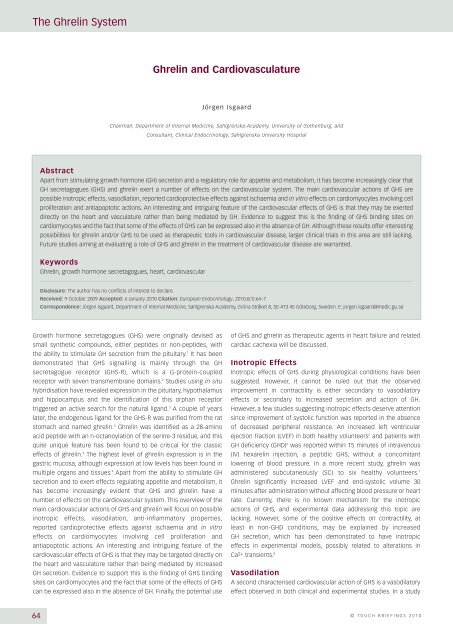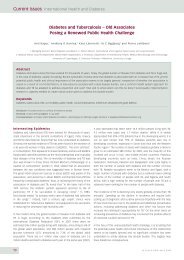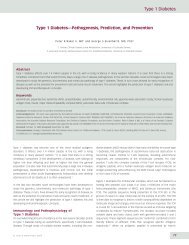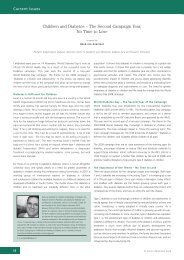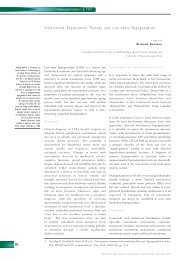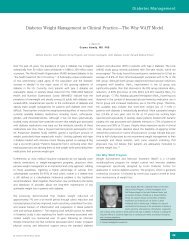The Ghrelin System - Touch Endocrinology
The Ghrelin System - Touch Endocrinology
The Ghrelin System - Touch Endocrinology
Create successful ePaper yourself
Turn your PDF publications into a flip-book with our unique Google optimized e-Paper software.
<strong>The</strong> <strong>Ghrelin</strong> <strong>System</strong><br />
<strong>Ghrelin</strong> and Cardiovasculature<br />
Jörgen Isgaard<br />
Chairman, Department of Internal Medicine, Sahlgrenska Academy, University of Gothenburg, and<br />
Consultant, Clinical <strong>Endocrinology</strong>, Sahlgrenska University Hospital<br />
Abstract<br />
Apart from stimulating growth hormone (GH) secretion and a regulatory role for appetite and metabolism, it has become increasingly clear that<br />
GH secretagogues (GHS) and ghrelin exert a number of effects on the cardiovascular system. <strong>The</strong> main cardiovascular actions of GHS are<br />
possible inotropic effects, vasodilation, reported cardioprotective effects against ischaemia and in vitro effects on cardiomyocytes involving cell<br />
proliferation and antiapoptotic actions. An interesting and intriguing feature of the cardiovascular effects of GHS is that they may be exerted<br />
directly on the heart and vasculature rather than being mediated by GH. Evidence to suggest this is the finding of GHS binding sites on<br />
cardiomyocytes and the fact that some of the effects of GHS can be expressed also in the absence of GH. Although these results offer interesting<br />
possibilities for ghrelin and/or GHS to be used as therapeutic tools in cardiovascular disease, larger clinical trials in this area are still lacking.<br />
Future studies aiming at evaluating a role of GHS and ghrelin in the treatment of cardiovascular disease are warranted.<br />
Keywords<br />
<strong>Ghrelin</strong>, growth hormone secretagogues, heart, cardiovascular<br />
Disclosure: <strong>The</strong> author has no conflicts of interest to declare.<br />
Received: 9 October 2009 Accepted: 6 January 2010 Citation: European <strong>Endocrinology</strong>, 2010;6(1):64–7<br />
Correspondence: Jörgen Isgaard, Department of Internal Medicine, Sahlgrenska Academy, Gröna Stråket 8, SE-413 45 Göteborg, Sweden. E: jorgen.isgaard@medic.gu.se<br />
Growth hormone secretagogues (GHS) were originally devised as<br />
small synthetic compounds, either peptides or non-peptides, with<br />
the ability to stimulate GH secretion from the pituitary. 1 It has been<br />
demonstrated that GHS signalling is mainly through the GH<br />
secretagogue receptor (GHS-R), which is a G-protein-coupled<br />
receptor with seven transmembrane domains. 2 Studies using in situ<br />
hybridisation have revealed expression in the pituitary, hypothalamus<br />
and hippocampus and the identification of this orphan receptor<br />
triggered an active search for the natural ligand. 3 A couple of years<br />
later, the endogenous ligand for the GHS-R was purified from the rat<br />
stomach and named ghrelin. 4 <strong>Ghrelin</strong> was identified as a 28-amino<br />
acid peptide with an n-octanoylation of the serine-3 residue, and this<br />
quite unique feature has been found to be critical for the classic<br />
effects of ghrelin. 4 <strong>The</strong> highest level of ghrelin expression is in the<br />
gastric mucosa, although expression at low levels has been found in<br />
multiple organs and tissues. 4 Apart from the ability to stimulate GH<br />
secretion and to exert effects regulating appetite and metabolism, it<br />
has become increasingly evident that GHS and ghrelin have a<br />
number of effects on the cardiovascular system. This overview of the<br />
main cardiovascular actions of GHS and ghrelin will focus on possible<br />
inotropic effects, vasodilation, anti-inflammatory properties,<br />
reported cardioprotective effects against ischaemia and in vitro<br />
effects on cardiomyocytes involving cell proliferation and<br />
antiapoptotic actions. An interesting and intriguing feature of the<br />
cardiovascular effects of GHS is that they may be targeted directly on<br />
the heart and vasculature rather than being mediated by increased<br />
GH secretion. Evidence to support this is the finding of GHS binding<br />
sites on cardiomyocytes and the fact that some of the effects of GHS<br />
can be expressed also in the absence of GH. Finally, the potential use<br />
of GHS and ghrelin as therapeutic agents in heart failure and related<br />
cardiac cachexia will be discussed.<br />
Inotropic Effects<br />
Inotropic effects of GHS during physiological conditions have been<br />
suggested. However, it cannot be ruled out that the observed<br />
improvement in contractility is either secondary to vasodilatory<br />
effects or secondary to increased secretion and action of GH.<br />
However, a few studies suggesting inotropic effects deserve attention<br />
since improvement of systolic function was reported in the absence<br />
of decreased peripheral resistance. An increased left ventricular<br />
ejection fraction (LVEF) in both healthy volunteers 5 and patients with<br />
GH deficiency (GHD) 6 was reported within 15 minutes of intravenous<br />
(IV) hexarelin injection, a peptidic GHS, without a concomitant<br />
lowering of blood pressure. In a more recent study, ghrelin was<br />
administered subcutaneously (SC) to six healthy volunteers. 7<br />
<strong>Ghrelin</strong> significantly increased LVEF and end-systolic volume 30<br />
minutes after administration without affecting blood pressure or heart<br />
rate. Currently, there is no known mechanism for the inotropic<br />
actions of GHS, and experimental data addressing this topic are<br />
lacking. However, some of the positive effects on contractility, at<br />
least in non-GHD conditions, may be explained by increased<br />
GH secretion, which has been demonstrated to have inotropic<br />
effects in experimental models, possibly related to alterations in<br />
Ca 2+ transients. 8<br />
Vasodilation<br />
A second characterised cardiovascular action of GHS is a vasodilatory<br />
effect observed in both clinical and experimental studies. In a study<br />
64 © TOUCH BRIEFINGS 2010
<strong>Ghrelin</strong> and Cardiovasculature<br />
by Kangawa and collaborators, a single injection of ghrelin caused a<br />
significant decrease in blood pressure. 9 In unpublished observations<br />
from our own laboratory, we also measured a modest but significant<br />
decrease in systolic blood pressure in hypophysectomised (hx) rats<br />
treated with ghrelin for two weeks. However, the vasodilatory effect of<br />
ghrelin and GHS is not entirely consistent in the literature, as<br />
described above. 5–7 This may possibly be due, at least in part, to<br />
differences in administration modes and dosing.<br />
Several possible mechanisms for the vasodilatory effect of GHS have<br />
been suggested. A recent study suggests an antagonistic action on<br />
the vasoconstrictor effect of endothelin-1 in mammary arteries. 10<br />
Studies on aortic ring preparations from GH-deficient rats treated<br />
with ghrelin showed an increased maximal acetylcholine-induced<br />
vasorelaxation compared with placebo, and this vasodilatory effect<br />
was accompanied by an increase in endothelial nitric oxide synthase<br />
(eNOS) production. 11 Moreover, the treatment effect of ghrelin could<br />
be inhibited by N(G)-nitro-L-arginine methyl ester, a non-selective<br />
NOS inhibitor, adding further support for a nitric-oxide-dependent<br />
pathway. However, the same research group has also reported<br />
possible vasodilatory effects independent of nitric oxide<br />
mechanisms. 12 Another interesting possible mechanism that has<br />
been reported is a central effect, involving decreased sympathetic<br />
nervous activity and arterial pressure, observed after unilateral<br />
microinjection of ghrelin into the nucleus of the solitary tract of rats. 13<br />
<strong>The</strong>se findings are in line with a previous report describing decreased<br />
mean arterial blood pressure and sympathetic nerve activity by<br />
ghrelin. 14 Additional support for this concept can be found in a recent<br />
study performed on conscious rats using the ghrelin antagonist<br />
(GhA) [d-Lys-3]-GHRP-6. Administration of this GhA revealed a<br />
dose-dependent increase in mean arterial pressure and heart rate<br />
that could be abolished by parallel sympathetic blockade of<br />
alpha- and beta-adrenoreceptors. 15<br />
Anti-inflammatory Effects<br />
Apart from vasodilatory effects, ghrelin may also have other<br />
vasoactive and anti-inflammatory properties. It has been shown that<br />
ghrelin inhibits cytokine release, activation of nuclear factor-κB and<br />
mononuclear cell binding in cultured human umbilical vein<br />
endothelial cells (HUVEC), which could potentially be important<br />
should GHS be considered as therapeutic agents in conditions with<br />
atherosclerosis. 16 It has also been reported that exogenous ghrelin<br />
inhibited synthesis of the pro-inflammatory cytokines interleukin<br />
(IL)-1β and tumour necrosis factor (TNF)-α in lipopolysaccharide<br />
(LPS)-stimulated murine macrophages. 17 Additional evidence for<br />
anti-inflammatory effects of ghrelin include the findings that<br />
T lymphocytes express both ghrelin and the GHS-R and that secretion<br />
of ghrelin is increased when the T lymphocytes are activated. 18 This<br />
may suggest a modulatory role on the immune system, since ghrelin<br />
was also reported to inhibit IL-1β, IL-6 and TNF-α in these cells. 18<br />
Cardioprotective Effects Against Ischaemia<br />
Accumulating evidence from several research groups using different<br />
experimental models supports cardioprotective effects of GHS against<br />
ischaemia. In one of the first studies addressing this topic, De<br />
Gennaro Colonna and collaborators used antiserum to GHRH in order<br />
to induce GH deficiency (GHD) in rats and then treated them with GH<br />
or hexarelin for two weeks. 19 After killing the rats their hearts were<br />
subjected to retrograde aortic perfusion under ischaemic conditions.<br />
Control rats with GH deficiency showed marked increase in left<br />
ventricular end-diastolic pressure (LVEDP) and poor recovery of<br />
contractility after reperfusion. By contrast, rats treated with GH or<br />
hexarelin had normalised cardiac function. In a further study from the<br />
same research group, hx rats were treated with GH or hexarelin,<br />
which again protected the hearts from cardiac damage during<br />
ischaemic reperfusion in vitro. 20 Interestingly, both of these studies<br />
suggest effects independent of increased GH secretion since the<br />
cardiovascular effects of hexarelin were expressed in two different<br />
models of GHD.<br />
Myocardial stunning is a clinical entity that can be defined as transient<br />
myocardial ischaemia followed by reperfusion, which causes a<br />
reversible cardiac dysfunction involving both systolic and diastolic<br />
function. A rabbit model has been used to study possible protective<br />
effects of GH and GHS on myocardial stunning. 21 Animals were<br />
pre-treated with GH or GHRP-2 for two weeks. Subsequently, hearts<br />
were blood-perfused and subjected to 15 minutes of ischaemia<br />
followed by 80 minutes of reperfusion and compared with<br />
non-ischaemic hearts. In this study there were no significant effects of<br />
either GH or GHRP-2 on systolic function. However, a significant<br />
improvement of diastolic function after pre-treatment with GHRP-2<br />
was observed, suggesting a novel therapeutic possibility for<br />
myocardial stunning.<br />
Experimental Models of<br />
Congestive Heart Failure<br />
In a previous study by our laboratory, an experimental approach was<br />
used. 22 Intact rats were subjected to experimental myocardial<br />
infarction by coronary artery ligation, and after four weeks of<br />
recovery, the rats were treated with two doses of hexarelin 10 or<br />
100μg/kg/day, GH 2.5mg/kg/day or saline for two weeks. Cardiac<br />
structure and function were evaluated with echocardiography at<br />
baseline and at the end of the experiment. Stroke volume was<br />
significantly increased in both the high-dose hexarelin group and the<br />
GH group compared with control rats. Similar findings were also seen<br />
regarding cardiac output, which was also increased by hexarelin and<br />
GH. Both of these parameters remained significantly elevated when<br />
normalised to bodyweight. Interestingly, only GH but not hexarelin<br />
treatment significantly increased bodyweight and kidney insulin-like<br />
growth factor I (IGF-I) messenger RNA (mRNA), suggesting that the<br />
effects of hexarelin were independent of GH.<br />
As an alternative method to coronary artery ligation, electric pacing of<br />
the heart has been developed as a model for impairing cardiac<br />
function. King and collaborators induced rapid pacing at 24bpm for<br />
three weeks in pigs. 23 An orally bioavailable GHS termed CP-424,391<br />
was administered to one group of animals at initiation of pacing. At<br />
the end of the experiment after three weeks of pacing and treatment,<br />
GHS-treated pigs had significantly higher fractional shortening and<br />
lower wall stress due to cardiac hypertrophy compared with control<br />
animals. Serum IGF-I was increased approximately two-fold, which<br />
would suggest an effect at least partially mediated by an increased<br />
GH secretion.<br />
Only a limited number of published studies so far have used ghrelin<br />
rather than synthetic GHS to study effects after myocardial injury.<br />
Kangawa and collaborators used rats with experimental myocardial<br />
infarction and treated them with ghrelin 100μg daily for three weeks. 24<br />
Echocardiography and catheterisation were used to evaluate effects<br />
EUROPEAN ENDOCRINOLOGY 65
<strong>The</strong> <strong>Ghrelin</strong> <strong>System</strong><br />
Figure 1: Schematic Illustration of Possible Interactions<br />
Between Growth Hormone Secretagogues/<strong>Ghrelin</strong>,<br />
Central Nervous <strong>System</strong> and the Cardiovascular <strong>System</strong><br />
Pituitary:<br />
GH release<br />
GH<br />
Heart:<br />
increased contratility,<br />
cardioprotection<br />
GHS/ghrelin<br />
CNS:<br />
decreased<br />
sympathetic<br />
activity<br />
Blood vessels:<br />
decreased peripheral resistance,<br />
anti-inflammatory actions<br />
Exogenous growth hormone (GH) secretagogues (GHS) or ghrelin can increase pituitary GH<br />
release leading to GH-mediated effects on the heart or the vasculature. Alternatively, GHS or<br />
ghrelin can act directly via binding sites in the cardiovascular system, promoting decreased<br />
peripheral resistance and cardioprotection. Anti-inflammatory effects on vascular cells and<br />
improved cardiac contractility have also been suggested as possible GHS/ghrelin effects.<br />
Interactions between ghrelin and the central nervous system (CNS) resulting in decreased<br />
sympathetic activity have also been proposed.<br />
GH<br />
suggested. 28 <strong>The</strong> CD36 receptor is a multifunctional B-type<br />
scavenger receptor and binding of hexarelin was found to occur in<br />
cardiomyocytes to a membrane protein identical to rat CD36<br />
receptor. One suggested GHS effect associated with activation of<br />
the CD36 receptor was coronary vasoconstriction. 28 This is<br />
intriguing and in contrast to otherwise reported vasodilatory effects<br />
of GHS. Whether the coronary vasoconstriction is specifically<br />
mediated by the CD36 receptor is not known, and more studies and<br />
better understanding of GHS binding sites are needed to clarify this.<br />
So to summarise, accumulating evidence suggests beneficial effects<br />
of GHS on both diastolic and systolic function after ischaemic injury,<br />
and this has been shown in several experimental models and species<br />
and to a limited extent in short-term clinical trials. Moreover, these<br />
effects are present also in the absence of GH, suggesting direct<br />
interaction between GHS and the cardiovascular system.<br />
Proliferative, Antiapoptotic and Metabolic<br />
Effects on Cardiomyocytes<br />
<strong>The</strong> possibility of GH-independent effects of GHS has prompted<br />
several studies on cultured cardiomyocytes to elucidate possible<br />
effects and signalling. In studies from our own laboratory, we have<br />
found that hexarelin and ghrelin increase thymidine incorporation,<br />
indicating increased proliferation of H9c2 cardiomyocytes in a dosedependent<br />
and specific manner. 29 Moreover, binding studies on<br />
cardiomyocyte cell membranes revealed specific binding in the<br />
absence of detectable expression of the GHS-R1a, 29 which is the<br />
classic cloned G-protein-coupled receptor expressed mainly in the<br />
pituitary and the hypothalamus. 2 This would suggest an alternative<br />
binding site in the heart. 29<br />
of ghrelin showing higher cardiac output and fractional shortening in<br />
ghrelin-treated rats compared with controls. Another study using<br />
echocardiography before and after four weeks of ghrelin<br />
administration to MI rats revealed improved systolic function and<br />
decreased LV remodelling. 25 Moreover, this improvement in function<br />
and structure was accompanied by a decreased inflammatory<br />
response and expression of metalloproteinases. 25 <strong>Ghrelin</strong> has also<br />
been reported to be protective when added in vitro during ischaemic<br />
reperfusion of isolated rat hearts. 25<br />
Differential Effects of Growth Hormone<br />
Secretagogues and <strong>Ghrelin</strong><br />
An interesting aspect that has been suggested is the possibility that<br />
cardioprotective effects may not be completely interchangable<br />
between different GHS and ghrelin. Torsello and collaborators<br />
recently suggested that cardioprotective effects against ischaemia<br />
after pre-treatment with hexarelin could not be replicated by<br />
ghrelin. 27 In this study, hx rats were pre-treated for seven days with<br />
either hexarelin or ghrelin and their hearts were subsequently<br />
subjected to ischaemia/reperfusion in vitro. During ischaemia there<br />
was a gradual increase of LVEDP pressure in hearts subjected to<br />
ischaemia compared with controls. Pre-treatment with hexarelin but<br />
not ghrelin partially normalised LVEDP and protected the hearts from<br />
injury. It could be speculated that this differential effect of hexarelin<br />
and ghrelin might be in part due to different affinities to a variety<br />
of subtype GHS receptors.<br />
An intriguing possibility that some of the cardiovascular effects of<br />
GHS may be mediated through the CD36 receptor was recently<br />
Possible antiapoptotic effects of GHS have also been studied on<br />
cardiomyocytes in vitro, and cell survival signalling has been described. 27<br />
Both ghrelin and desoctanoyl ghrelin had similar antiapoptotic effects on<br />
primary cardiomyocytes, H9c2 cardiomyocytes and endothelial cells<br />
with signalling via MAPK and PI3K/Akt-dependent pathways. 30<br />
In a recently published study, hexarelin was found to decrease<br />
apoptosis induced by angiotensin-II in cultured rat cardiomyocytes. 31<br />
Using the Tunnel assay, hexarelin was found to significantly decrease<br />
apoptosis and to inhibit caspase-3 activity and Bax expression.<br />
Moreover, expression of Bcl-2 was increased, providing evidence<br />
for antiapoptotic effects of hexarelin through well-established<br />
antiapoptotic signalling. Thus, in vitro findings would support both<br />
proliferative and antiapoptotic effects of GHS involving signalling via<br />
well-established cell survival pathways.<br />
Another potentially important effect of ghrelin on cardiomyocytes<br />
was recently reported and involves stimulation of 5’-AMP-activated<br />
protein kinase (AMPK). 32 This kinase has a central role in regulating<br />
energy supplies in cells and is activated in anaerobic conditions. Thus,<br />
a beneficial effect of ghrelin on cellular energy supply may contribute<br />
to the mechanism of cardioprotection. 33<br />
Clinical Use of <strong>Ghrelin</strong> and Growth Hormone<br />
Secretagogues in Heart Failure<br />
<strong>The</strong> experience from clinical trials with GHS and ghrelin in conditions<br />
with impaired cardiac function is also very limited. Acute<br />
administration of hexarelin increased LVEF in patients with ischaemic<br />
but not dilated cardiomyopathy. 34 A more recent clinical trial with acute<br />
66<br />
EUROPEAN ENDOCRINOLOGY
<strong>Ghrelin</strong> and Cardiovasculature<br />
administration of ghrelin to patients with congestive heart failure<br />
demonstrated beneficial effects. 35 Twelve patients with CHF were given<br />
a single IV infusion of human ghrelin or placebo. <strong>Ghrelin</strong> significantly<br />
increased cardiac index and stroke volume index and decreased<br />
systemic vascular resistance within 60 minutes. Moreover, in<br />
anaesthetised patients undergoing bypass surgery, short-term<br />
hexarelin infusion was found to increase LVEF, cardiac output and<br />
mean arterial pressure without any changes in peripheral resistance. 36<br />
Only one study with longer duration of treatment of patients with<br />
congestive heart failure has been published so far. 37 In this open study,<br />
10 patients with congestive heart failure of heterogeneous aetiology<br />
were treated with IV ghrelin for three weeks. <strong>Ghrelin</strong> significantly<br />
increased LVEF, LV mass and LV end-systolic volume. Moreover, ghrelin<br />
also increased peak workload and peak oxygen consumption during<br />
exercise and there was a reported decrease in plasma norepinephrine.<br />
No serious adverse events were observed.<br />
End-stage CHF is sometimes associated with cachexia, which is a<br />
severe catabolic state characterised by weight loss and muscle<br />
wasting. Thus, it is tempting to speculate that ghrelin and GHS may<br />
have multiple beneficial effects on this patient population by exerting<br />
both positive cardiovascular and orexigenic actions. To date, there are<br />
no long-term clinical trials substantiating this hypothesis, although<br />
preliminary data suggest that administration of ghrelin increases<br />
muscle strength and lean body mass in patients with CHF. 37 Whether<br />
GHS and ghrelin will find a role as therapeutic agents in the treatment<br />
of congestive heart failure remains to be further investigated in more<br />
long-term and placebo-controlled trials. However, the clinical studies<br />
published to date certainly open interesting possibilities. In relation to<br />
established agents used for treatment of CHF, GHS and ghrelin may<br />
have additional potentially beneficial properties such as orexigenic,<br />
anti-inflammatory and antiapoptotic effects and a regulatory role<br />
regarding myocardial energy supplies.<br />
Conclusion<br />
Although initially recognised for its GH-releasing properties, the<br />
cardiovascular system has been recognised as potentially important<br />
target for GHS. Moreover, a limited number of studies also indicate<br />
cardiovascular effects of ghrelin. So far, reported cardiovascular<br />
effects of GHS and/or ghrelin include lowering of peripheral<br />
resistance, anti-inflammatory effects, possible improvement<br />
of contractility and cardioprotective effects both in vivo and in vitro<br />
(see Figure 1). Moreover, central effects effects by ghrelin, possibly<br />
mediated in part by the sympathetic nervous system, may also affect<br />
the cardiovascular system.<br />
Taken together, these results offer an interesting perspective on the<br />
future where further studies aiming at evaluating a therapeutic role<br />
for GHS and ghrelin in the treatment of cardiovascular disease<br />
are warranted. n<br />
Jörgen Isgaard is Chairman of the Department of<br />
Internal Medicine at the Sahlgrenska Academy,<br />
University of Gothenburg, and a Consultant in Clinical<br />
<strong>Endocrinology</strong> at Sahlgrenska University Hospital. His<br />
main scientific interest is translational research in the<br />
field of growth hormone (GH), GH secretagogues and<br />
interactions with the cardiovascular system and the<br />
central nervous system. He has published more than<br />
100 scientific papers. He received his MD in 1984 and<br />
completed his PhD thesis in 1989.<br />
1. Bowers CY, Chang J, Momany FA, Folkers K, Molecular<br />
Endocrinol, Amsterdam: Elsevier/North Holland Biochemical<br />
Press, 1977;287–92.<br />
2. Howard AD, Feighner SD, Cully DF, et al., Science,<br />
1996;273:974–7.<br />
3. Kojima M, Kangawa K, Physiol Rev, 2006;85:495–522.<br />
4. Kojima M, Hosoda H, Date Y, et al., Nature,<br />
1999:402:656–66.<br />
5. Bisi G, Podio V, Valetto MR, et al., J Endocrinol Invest,<br />
1999;22:266–72.<br />
6. Bisi G, Podio V, Valetto MR, et al., Eur J Pharmacol,<br />
1999;381:31–8.<br />
7. Enomoto M, Nagaya N, Uematsu M, et al., Clin Sci,<br />
2003;105:431–5.<br />
8. Strömer H, Cittadini A, Douglas PS, et al., Circ Res,<br />
1996;79:227–36.<br />
9. Nagaya N, Kojima M, Uematsu M, et al., Am J Physiol Regul<br />
Integr Comp Physiol, 2001;280:R1483–7.<br />
10. Wiley KE, Davenport AP, Br J Pharmacol, 2002;136:1146–52.<br />
11. Shimizu Y, Nagaya N, Teranishi Y, et al., Biochem Biophys Res<br />
Commun, 2003;310:830–35.<br />
12. Okumura H, Nagaya N, Enomoto M, et al., J Cardiovasc<br />
Pharmacol, 2002;39:779–83.<br />
13. Lin Y, Matsumura K, Fukuhara M, et al., Hypertension,<br />
2004:43:977–82.<br />
14. Matsumura K, Tsuchihashi T, Fujii K, et al., Hypertension,<br />
2002;40:694–9.<br />
15. Vlasova MA, Järvinen K, Herzig KH, Regul Pept,<br />
2009;156:72–6.<br />
16. Li WG, Gavrila D, Liu X, Wang L, et al., Circulation,<br />
2004;109:2221–6.<br />
17. Waseem T, Duxury M, Ito H, et al., Surgery,<br />
2008;143:334–42.<br />
18. Dixit VD, Schaffer EM, Pyle RS, et al., J Clin Invest,<br />
2004;114:57–66.<br />
19. De Gennaro Colonna V, Rossoni G, Bernareggi M, et al.,<br />
Eur J Pharmacol, 1997;334:201–7.<br />
20. Locatelli V, Rossoni G, Schweiger F, et al., <strong>Endocrinology</strong>,<br />
1999;140:4024–31.<br />
21. Weekers F, Van Herck E, Isgaard J, et al., <strong>Endocrinology</strong>,<br />
2000;141:3993–9.<br />
22. Tivesten A, Bollano E, Caidahl K, et al., <strong>Endocrinology</strong>,<br />
2000;141:60–66.<br />
23. King MK, Gay DM, Pan LC, et al., Circulation,<br />
2001;103:308–13.<br />
24. Nagaya N, Uematsu M, Kojima M, et al., Circulation,<br />
2001;104:1430–35.<br />
25. Huang CX, Yuan MJ, Huang H, et al., Peptides,<br />
2009;30:2286–91.<br />
26. Chang L, Ren Y, Liu X, et al., J Cardiovasc Pharmacol,<br />
2004;43:165–70.<br />
27. Torsello A, Bresciani E, Rossoni G, et al., <strong>Endocrinology</strong>,<br />
2003;144:1787–92.<br />
28. Bodart V, Febbraio M, Demers A, et al., Circ Res,<br />
2002;90:844–9.<br />
29. Pettersson I, Muccioli G, Granata R, et al., J Endocrinol,<br />
2002;175:201–9.<br />
30. Baldanzi G, Filigheddu N, Cutrupi S, J Cell Biology,<br />
2002;159:1029–37.<br />
31. Pang JJ, Xu RK, Xu XB, et al., Am J Physiol Heart Circ Physiol,<br />
2004;286:H1063–9.<br />
32. Kola B, Hubina E, Tucci SA, et al., J Biol Chem,<br />
2005;280:25196–201.<br />
33. Garcia EA, Korbonits M, Curr Opin Pharmacol, 2006;6:142–7.<br />
34. Broglio F, Benso A, Valetto MR, et al., Endocrine,<br />
2001;14:105–8.<br />
35. Nagaya N, Miyatake K, Uematsu M, et al., J Clin Endocrinol<br />
Metab, 2001;86:5854–9.<br />
36. Broglio F, Guarracino F, Benso A, et al., Eur J Pharmacol,<br />
2002;448:193–200.<br />
37. Nagaya N, Moriya J, Yasumura Y, et al., Circulation,<br />
2004;110:3674–9.<br />
EUROPEAN ENDOCRINOLOGY 67


